Agricultural fencing
This article needs additional citations for verification. (December 2007) |
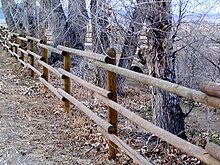
In agriculture, fences are used to keep animals in or out of an area. They can be made from a wide variety of materials, depending on terrain, location and animals to be confined. Most agricultural fencing averages about 4 feet (1.2 m) high, and in some places, the height and construction of fences designed to hold livestock is mandated by law.
A fencerow is the strip of land by a fence that is left uncultivated. It may be a
History

Historically throughout most of the world, domesticated livestock would roam freely and were fenced out of areas, such as gardens or fields of crops, where they were unwanted. Over time, especially where crop agriculture became dominant and population density of both humans and animals was significant, livestock owners were made to fence their animals in.
The earliest fences were made of available materials, usually stone or wood, and these materials are still used for some fences today. In areas where field stones are plentiful, fences have been built up over the years as the stones are removed from fields during tillage and planting of crops. The stones were placed on the field edge to get them out of the way. In time, the piles of stones grew high and wide.
In other areas, fences were constructed of
Fence laws
The tradition of fencing out unwanted livestock prevails even today in some sparsely populated areas. For example, until the mid-20th century, most states in the American West were called "open range" ("fence out") states, in contrast to Eastern and Midwestern states which long had "fence in" laws where livestock must be confined by their owners. Though the open range was part of the western tradition, over time, open range was limited long before it was eliminated; first came an obligation to keep cattle from roaming onto state and federal highways, where collisions with fast-moving cars and trucks created a public safety hazard. In addition, voters could voluntarily choose to make certain heavily farmed areas a "herd district," where livestock needed to be fenced in, a process that also became popular in areas where development of hobby farms created conflicts between large and small landowners. Over time, court cases steadily limited the application of open range law until the present day, where it is the exception rather than the rule in many parts of the American West.
In the United Kingdom, the law is different for private land and common land. On private land it is the owner's responsibility to fence livestock in, but it is the responsibility of landowners bordering a common to fence the common's livestock out.
Additionally, railways in the UK are fenced to keep livestock and people out, since it is a requirement to do so, unlike many other countries. Either Network Rail or the landowner are responsible for maintaining the fences.[3]
Fence styles
Wire fences
The principle of wire fences is that they are supported mainly by tension, being stretched between heavy strutted or guy-wired posts at ends, corners, and ideally at intervals in longer stretches (every 50 to 300 metres, 150 to 1000 feet). Between these braced posts are additional smaller wooden or metal posts which keep the wires spaced and upright, usually 3 to 6 metre (10 to 20 feet) apart, depending on the style of fencing used.
Traditionally, wire fencing material is made of
Wire fences are typically run on wooden posts, either from trees commercially grown in
Other than in a truly desert climate, use of rot-resistant wooden posts or steel posts is advised. In the United States, wood with natural rot resistance, such as oak and juniper, was often used until it became in short supply in the 1950s. Then, chemically treated pine and spruce posts became prevalent, and these are also widely used in Britain, together with chestnut. Creosote, pentachlorophenol, and chromated copper arsenate are all widely used in the US and elsewhere for treatment (although some of these chemicals are subject to legal controls).
Barbed wire


The Industrial Revolution brought the first barbed wire (also "barbwire" or just "barb") fences, which were widely used after their introduction in the mid-19th century. This technology made it economically feasible to fence rangeland for the first time. In the United States, introduction of barbed wire contributed to the range wars of that century, as various ranch interests attempted to use barbed wire fences to claim exclusive access to the best pasture and water resources, including those lands in the public domain. It also exacerbated tensions between cattle ranchers and crop farmers, partly when access to water was involved.
Barbed wire has been made by many manufacturers in an almost endless variety of styles. For the most part these were functionally identical. The differences reflected peculiarities of each manufacturing process rather than deliberate design of the end product. Sections of unusual barbed wire are collected by some enthusiasts.
The traditional barbed wire used since the late 19th century and into the present day was made from two
Typically four strands of barbed wire, with the lowest strand no more than 12 inches (300 mm) from the ground and the top strand at least 48 inches above the ground, make up a legal fence in the western United States. Better-quality fences have five strands, older fences often had only three strands, and just two strands is widely used in Britain if only adult cattle are being contained. Other variations exist, depending on local laws and the purpose of the fence.
Barbed wire is particularly effective for containing
Smooth wire

Smooth (or plain) wire is essentially the same product as barbed wire with no barbs – either a two-wire twist or a single strand. Its primary advantage is that it is less likely to cause lacerations and cuts if an animal becomes entangled in it or rubs against it. However, animals will readily lean on mild steel smooth wire, stretching it out of shape or loosening it from the posts, and for this reason it is often used in high-tensile form, which more easily springs back to its original length. Smooth wire fencing is often used as an inexpensive material to safely contain horses and other animals that run a high risk of entanglement, usually in conjunction with a line of electric fence. Smooth wire is also used in securing fence-post braces and other uses where barbed wire is not recommended
High tensile wire
High tensile (H-T or HT) fencing is a special hard, springy steel wire nor by fallen trees or branches. It can be insulated and electrified. Because of the wide spacing of the posts, thin metal or wood spacers (or "droppers") may be attached to the wires between posts to maintain their spacing.
Joining HT wire is difficult because of its stiffness and its reduction in strength when bent sharply. However, it may be joined effectively with proprietary clips. HT wire is more expensive than mild steel, but because of the need for fewer posts, the overall cost of the fencing is usually comparable.
Because it does not stretch, animals are less likely to become entangled in HT wire. However, for the same reason, if an animal does become entangled or runs into a few strands at a high speed, it can be deadly, and is sometimes referred to as having a "
Trellising for horticultural purposes is generally constructed from HT wire as it is able to withstand a higher crop load without breaking or stretching.
Woven and mesh wire
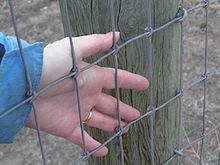
Woven and mesh wire fencing material has smooth horizontal wires and vertical wires (called stays). Wire spacing and height of fence is dependent on which type of animal is being contained.[9] Agricultural woven wire is identifiable by wire "knots" wrapped around each intersecting wire. Mesh wire material is spot welded at each junction. Woven wire and mesh wire fences are also called square wire, box wire, page wire, sheep fence, or hog fence in the United States, sheep netting or pig netting in Britain, and ringlock in Australia.
Barbed wire fences cannot effectively contain smaller livestock such as pigs, goats or sheep. Where these animals are to be fenced, woven wire is used instead, sometimes with one or more strands of barbed wire at the top, and sometimes at the bottom to prevent animals from pushing under.[10]: 15 For swine, a ground-level barbed wire strand or electrified wire is used as well to prevent digging beneath the fence.
Woven wire with large openings has some potential hazards. Large hoofed animals can put a foot through wide squares while grazing along the edge of the fenceline or while reaching over it, and then become tangled in the fence. A variation, called "field fence," has narrower openings at the bottom and wider openings at the top, which helps prevent animals from putting their feet through the fence. For example, horses in particular are safer kept inside woven wire fence with smaller openings, such as "no climb" fence with openings no larger than two inches by four inches.[11]
Hog panel
Hog panels or cattle panels consist of heavy wire approximately .25 inches (6 mm) or more in diameter running horizontal and vertical, and welded at the intersections. The panels, which are sold in lengths of 16 ft or 8 ft rather than in rolls, are rigid and self-supporting. No corner bracing is needed with panels as they are not stretched and there is no tension on corner posts.[10]: 61
Chain link
Electric fence
Electric fencing became widely available in the 1950s and has been widely used both for
A fence charger places an electrical pulse from ground to the wire about once per second. The pulse is narrow and usually around 5-20 kV. Animals receive an uncomfortable but harmless shock when contacting the wire, and learn to stay away from it.
-
In addition to single strand wire, electric fencing is also made of synthetic materials with fine wire interwoven throughout the fence strands
-
Detail of electric cord fence with metal interwoven with nylon cord, attached to a steel fence post with a plastic insulator
Synthetic fence
This section needs additional citations for verification. (October 2010) |
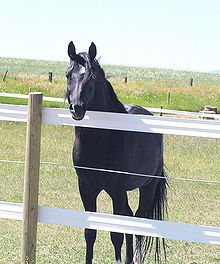
A variant, sometimes called "vinyl rail" or "strap fencing" consists of two or more vinyl-encased wires with vinyl or other synthetic between them to create a "rail" that is anywhere from 1 to 10 centimetres (0 to 4 in) wide. Some forms may be electrified by use of a special coating on the top wire of the "rail."
Vinyl fence is installed in a manner similar to plain high-tensile fence and must be stretched tight. Strong bracing of posts at corners and in the middle of long fencelines is required. Like other wire fences, keeping vinyl fencing tightened on a regular basis is key to safety and appearance.
A mesh form of vinyl fencing without internal wires is marketed as "deer fence" and used in some locations to augment other fencing to keep out wild animals. There are also some forms of vinyl fencing that look similar to vinyl-coated wire, but do not contain an internal wire, that are marketed to livestock owners. They are marketed as particularly safe, but their strength in containing animals is under debate.
Wood, pipe and other materials
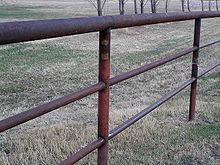
Fences of wood, stranded cable, and pipe are used where cost is less of a consideration, particularly on horse farms, or in pens or corrals where livestock are likely to challenge the fence. Synthetic materials with wood-like qualities are also used, though they are the most expensive option in most situations. In some areas, these types of fencing materials can be cost-effective if plentiful. For example, scrap pipe is often easily obtained at a low price if oil fields are nearby, and wooden rails can sometimes be harvested from the owner's own land if it contains suitable standing timber.
A cattle grid is an obstacle used to prevent livestock, such as sheep, beeves, pigs, horses, or mules from passing along a road or railway which penetrates the fencing surrounding an enclosed piece of land or border.
Maintenance
All types of agricultural fencing require regular maintenance to ensure their effectiveness. Cattle and horses are strong enough to go through most types of fence by main force, and occasionally do so when frightened or motivated by hunger, thirst, or sex drive. Weather, flood, fire, and damage from vandals or motor vehicle accidents can do similar damage and may allow livestock to escape.
Wildlife issues
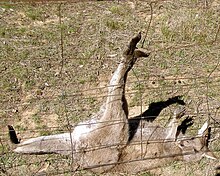
All types of livestock fencing can be barriers and traps for wildlife, causing injuries and fatalities. Wildlife can get their legs tangled in barbed wire or woven wire with a strand of barbed on top. Woven wire can barricade animals that cannot jump the fence but are too large to crawl through the holes, such as fawns, bears and bobcats. Some wire fences are too difficult to see for larger fast moving birds, which can get entangled in it.[12]
Adding visibility to wire fences can help reduce wildlife collisions. Reducing the height of woven and strand wire fences to no more than 40 inches can make it easier for wildlife to jump over with less risk of entanglement. Using barbless wires on top and bottom reduces cuts on wildlife which crawl under strand fences or those that try to climb over.[12]
Deer and many goats can easily jump an ordinary agricultural fence, and so special fencing is needed for farming goats or deer, or to keep wild deer out of farmland and gardens. Deer fence is often made of lightweight woven wire netting nearly 2 metres (6 feet 7 inches) high on lightweight posts, otherwise made like an ordinary woven wire fence. In areas where such a tall fence is unsuitable (for example, on mountains subject to very high winds), deer may be excluded (or contained) by a fence of ordinary height (about 1.5 metres [4 feet 11 inches]), with a smaller one of about 1 metre (3 feet 3 inches) high, about 1 metre (3 feet 3 inches) away from it, on the same side as the deer. The additional width prevents deer approaching the fence close enough to jump it.
See also
References
- ^ "Fencerows". Missouri Dept. of Conservation.
A brushy fencerow, which can provide an important link between different habitat types on your property, is an ideal place to start habitat improvement work. The simplest way to make or improve a travel lane is to stop mowing, grazing, or cultivating the strip next to the fence.
- ^ "Hedgerows". Farmscape Ecology Program. Hawthorne Valley, NY.
When we discuss "hedgerows", we also mean windbreaks or fencerows – basically any stretch of woody vegetation bordered on either side by grass and/or brush.
- ^ "Railway fencing safety: What livestock farmers need to know". 21 August 2021.
- ^ Magazines, Hearst (December 30, 1934). Popular Mechanics. Hearst Magazines. Handy Wire-Pulling Tool Has Many Uses – via Internet Archive.
Popular Science 1935 plane Popular Mechanics.
- ^ "Steel posts and accessories" (PDF).
- ^ "Archived copy" (PDF). Archived from the original (PDF) on 2011-07-15. Retrieved 2010-11-03.
{{cite web}}: CS1 maint: archived copy as title (link) - ^ "382spec" (PDF). Archived from the original (PDF) on 2010-10-08. Retrieved 2010-11-03.
- ^ "Quality Ranch Fence Materials | Tejas Ranch & Game Fence". Tejas Ranch & Game Fence. Retrieved 2018-08-21.
- ^ Worley, John W (February 20, 2015). "Fences for the Farm". University of Georgia Extension.
- ^ a b Building Fences. American Association for Vocational Instructional Materials. 1974.
- ^ "Safe Pasture Fencing for Horse Pastures, Horse Fields & Horse Paddocks". equisearch.com. April 30, 2007.
One standard fence style you don't want to use is field fence, or "box wire." Box wire is dangerous for horses as the openings are large enough for a horse to put a foot through. Better are woven wire fences with small 2" x 4" openings or with the even smaller diamond mesh.
- ^ a b Paige, Christine (2008). "A Landowner's Guide to Wildlife Friendly Fences: How to Build Fence with Wildlife in Mind" (PDF). Montana Department of Fish, Wildlife and Parks.
External links
- Fence Planning for Horses Archived 2015-02-02 at the Wayback Machine


